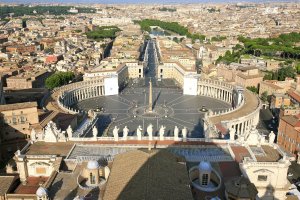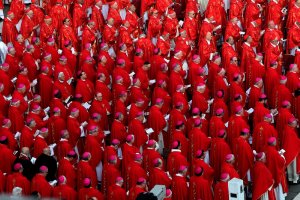Pope Francis is setting the stage for an unprecedented overhaul of the power structure within the Roman Catholic Church—a change aimed at reforming the institution’s hierarchical decision-making mechanism by replacing it with a decentralized system of authority.

This month, the Pope initiated a two-year review process in preparation for the Church’s October 2023 assembly of bishops from around the world. The meeting, known as a Synod, is held in Rome at regular intervals to discuss and advise the Pope about issues important to the Church.
It is not about “gathering opinions,” he said but “listening to the Holy Spirit.”
With the theme, “For a Synodal Church: Communion, Participation and Mission,” the 2023 meeting will potentially revolutionize not just how the Catholic Church makes decisions but also how its members interact.
The review process, aided by a five-member steering committee and two commissions on methodology and theology, will unfold in three phases. The first phase, from October 2021 to April 2022, will be on the “local” level, involving dioceses and parishes.
The second stage, known as the “continental phase,” will revolve around seven international conferences of bishops, which will be tasked with producing seven documents.
The final phase will culminate in the October 2023 Synodal meeting in which bishops and auditors (officials delegated to gather information during previous phases) will convene in Rome “to speak and listen to one another on the basis of the Synodal process that began at the local level,” according to a September 2021 communiqué by the Vatican press office.
“The hope is that the experience of the Synodal process will bring about a new springtime for listening, discernment, dialogue and decision-making, so that the whole People of God can better journey together with one another and the entire human family, under the guidance of the Holy Spirit,” states the communiqué.
“We can say that basically Pope Francis wants to see a Church in which a broader spectrum of the faithful have a voice and a share in responsibility for the life of our Church,” wrote Cardinal John Dew, Archbishop of the Catholic Archdiocese of Wellington, New Zealand, in an article in August on the archdiocese website. “What he is saying and hoping for involves the coming together of all members of the Church, regardless of their status or whatever position they hold to achieve some religious purpose, which could not be achieved in the same way without such a gathering.”
Reforming the Synodal process has been high on Pope Francis’s list of priorities. As a cardinal and rapporteur for the summit of bishops at the Vatican in 2001, he disagreed with the Catholic Church’s top-down decision-making structure.
The new structure will be more like a spiral than an inverted pyramid, according to Rafael Luciani, a professor at the Andres Bello Catholic University in Caracas, Venezuela, and Professor Extraordinarius at the School of Theology and Ministry at Boston College, Massachusetts.
Luciani, a member of the Synod’s theology commission, is tasked with coordinating seminars across Catholic churches in Latin America. He sees the unfolding Synodal process as one in which decisions will be sent from the dioceses to bishops’ conferences to the Vatican—and back again. “For the first time,” he said, “there is an interaction—it is not a linear way of proceeding.”
______________
The Church of Scientology publishes this blog to help create a better understanding of the freedom of religion and belief and provide news on religious freedom and issues affecting this freedom around the world.
The Founder of the Scientology religion is L. Ron Hubbard and Mr. David Miscavige is the religion’s ecclesiastical leader.
For more information, visit the Scientology website or the Scientology TV network.


